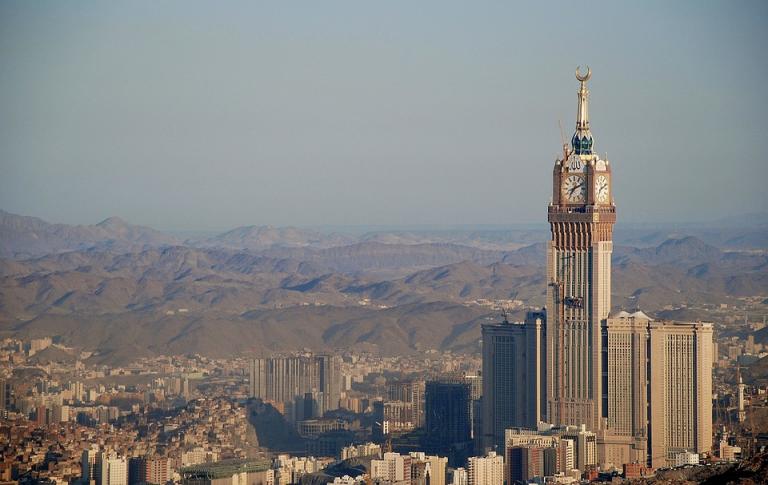First, from Bloomberg View on Friday, “The Right Dream for Saudi Arabia,” which describes the Deputy Crown Prince’s plan to sell shares in the state oil company and use the proceeds to create a diversified Sovereign Wealth fund, and prescribes a larger agenda: in order to reform its economy, remedy existing problems and plan for a future with less oil wealth,
A population accustomed to relying on immigrant labor and government assistance will have to work more and pay taxes. At the same time, the state will have to be more responsive to the citizens it’s now asking to start businesses and fend for themselves. It will have to provide them with better health care and an educational system that helps them succeed in a new economy. More women will need to work (and drive to work, too). Fewer princes will be able to enjoy luxurious lifestyles at state expense. And when there is political unrest, the government will have to resist the temptation to buy off the opposition.
The staff editorial references a news article, “Saudi Arabia Plans $2 Trillion Megafund for Post-Oil Era: Deputy Crown Prince,” which describes the objective as that of helping “wean the kingdom off oil,” though the objective appears to be more about helping the government obtain diversified sources of revenues, rather than building a diversified employment base for the Saudi people.
This reminded me of an article I had read, and saved to my facebook page (have you liked Jane the Actuary on Facebook yet?), a while back, from the New York Times, “Young Saudis See Cushy Jobs Vanish Along With Nation’s Oil Wealth.”
For decades, the royal family has used the kingdom’s immense oil wealth to lavish benefits on its people, including free education and medical care, generous energy subsidies and well-paid (and often undemanding) government jobs. No one paid taxes, and if political rights were not part of the equation, that was fine with most people.
But the drop in oil prices to below $30 a barrel from more than $100 a barrel in June 2014 means that the old math no longer works. Low oil prices have knocked a chunk out of the government budget and now pose a threat to the unwritten social contract that has long underpinned life in the kingdom, the Arab world’s largest economy and a key American ally.
The Saudi workforce is similar to Greece in that, in both places, government jobs are cushy and highly desired, and private sector jobs are scorned — in fact, 70% of the Saudi workforce (as opposed to expats/guest workers) work in government jobs. The country is young, which makes for large numbers of new job seekers, ill-prepared from their univesity training for skilled and professional jobs, where guest workers are preferred for their skills and their work ethic. And the Times describes the situation even at McDonalds:
In recent years, the government has pushed for greater Saudi employment, penalizing companies with few Saudi employees. Many employers hate the program, saying it forces them to swell their payrolls with people who contribute little.
Even companies that have hired lots of Saudis have often had to rely on significant social engineering to get them working.
Saudis made up one-third of the crew at a Riyadh McDonald’s on a recent morning, manning the drive-up window and cash register and making fries.
“Is this spicy?” one yelled to a colleague. “One large fries, please!”
While they do the same work as foreigners, they earn much more. Salaries for foreign crew start at $320 a month, while Saudis get $1,460, part of which is subsidized by the government.
Which led me to dig into the situation a bit more, and find an article from The Guardian from 2013, “Saudi Arabia’s riches conceal a growing problem of poverty,” according to which
press reports and private estimates suggest that between 2 million and 4 million of the country’s native Saudis live on less than about $530 a month – about $17 a day – considered the poverty line in Saudi Arabia.
The kingdom has a two-tier economy made up of about 16 million Saudis, with most of the rest foreign workers. The poverty rate among Saudis continues to rise as youth unemployment skyrockets.
But details are hard to come by. According to Wikipedia, 80% of its private-sector workers are foreign workers, and, though its unemployment rate across the entire workforce is 5.3%, for Saudi youths ages 16 – 29, it’s 29%. Are they truly unable to get jobs because private sector workers are able to hire foreigners instead? Are they unwilling to accept jobs they consider as beneath them, while they wait for the right, middle-class, take-it-easy job to open up?
Another tidbit: one always hears that they have a high fertility rate, because women have nothing better to do, being restricted from pretty much everything else. But according to the World Factbook, their fertility rate is right at replacement — but I was unable to figure out whether this is artificially low because a great portion of the childbearing-age population consists of foreign workers who are forbidden from bringing spouses along. Are they included in the metrics, giving the impression of a lower birth rate than is the case for Saudi nationals? The World Bank reports their TFR is much higher, at 2.8, which is odd, because usually the two sources are pretty close.
And that’s as far as I’ve gotten, except that I now have a library book to read on the topic!













